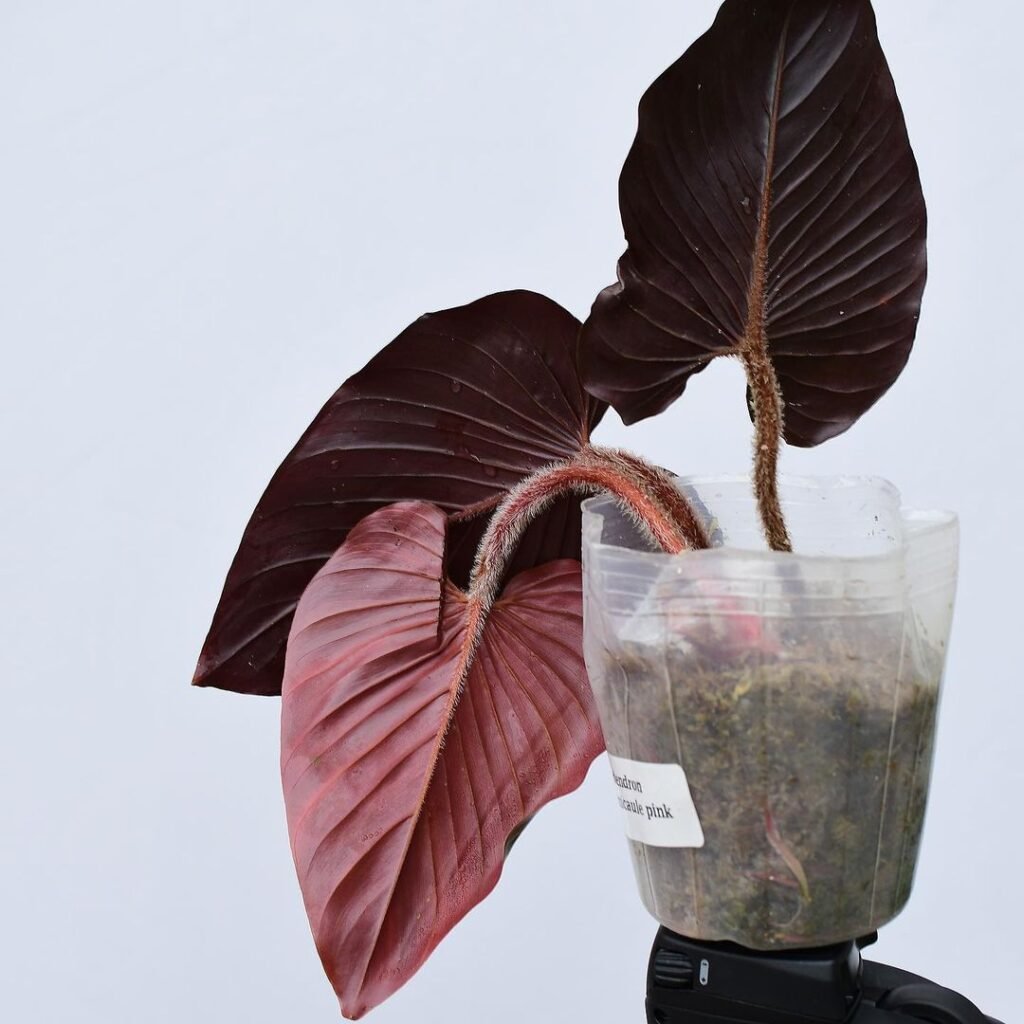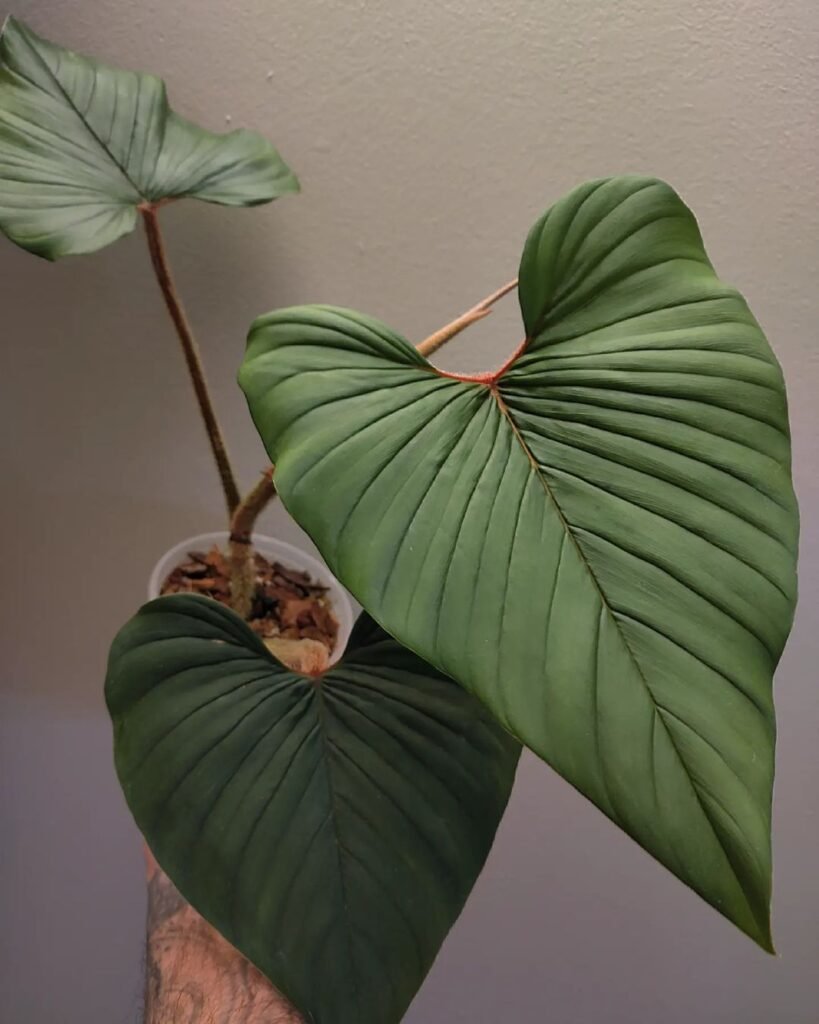Welcome to the definitive guide on cultivating and caring for Philodendron Squamicaule, the mesmerizing plant native to Panama, Nicaragua, Ecuador, and Colombia. In this comprehensive guide, we present unparalleled insights into every facet of Philodendron Squamicaule care. From its captivating appearance to meticulous propagation techniques, we aim to equip you with the knowledge needed to nurture this botanical marvel with precision.

Unveiling the Beauty of Philodendron Squamicaule
Philodendron Squamicaule stands out with its remarkable aesthetics. The plant boasts large, heart-shaped leaves, ranging from 10.2 to 20.8 inches in length and 6.9 to 15.7 inches in width. The glossy leaves feature reddish lateral veins, adding a touch of drama. The petioles, with their scaly and reddish appearance, contribute to the plant’s allure. Dark green stems, growing up to 30 cm, complete the visual symphony, making Philodendron Squamicaule an exquisite addition to any indoor space.

Illuminating the Path: Light Requirements
To unlock the full potential of your Philodendron Squamicaule, ensure it basks in bright, indirect sunlight. While it tolerates some morning direct sunlight, shield it from harsh afternoon rays to prevent leaf burn. Optimal placement near a south-facing window provides consistent, indirect sunlight, fostering robust growth and vibrant foliage. Adequate light sustains the plant’s health, preventing issues like elongated stems and vulnerable leaves.
Nourishment Rituals: Watering Wisdom
Proper watering is the cornerstone of Philodendron Squamicaule‘s vitality. Maintain a delicate balance by watering when the top two centimeters of soil dry out. Guard against overwatering, a potential nemesis leading to root rot and other complications. During the dormant winter phase, reduce watering frequency to once a week, aligning with the plant’s slowed growth.
10 Philodendron Varieties: A Comprehensive Guide
Fertilizing for Flourishing Foliage
To fuel robust growth, regularly fertilize Philodendron Squamicaule during its active growth phase, typically monthly. Any houseplant fertilizer suffices; follow package instructions for optimal results. In the dormant fall and winter, reduce fertilization to once every 2 to 3 months, using slow-releasing fertilizer to sustain the plant through the dormant period.
Potting: Liberation from Rootbound Constraints
Detect signs of a rootbound plant, such as dry, lackluster leaves or roots escaping above the soil. When repotting, choose a well-draining soil with a pH range of 6 to 7, ensuring proper air circulation for the roots. Post-repotting, hydrate the plant adequately to facilitate a seamless transition.

Propagation Mastery
Philodendron Squamicaule can be propagated through stem cuttings. Whether opting for water or soil propagation, strategic measures guarantee success. For water propagation, submerge nodes underwater, changing water regularly. Soil propagation demands a mix of peat moss and perlite, maintaining consistent moisture without succumbing to overwatering pitfalls.
Growth Chronicles
Witness the evolution of Philodendron Squamicaule, reaching up to 30 cm in length. The reddish petioles and dramatic heart-shaped leaves create an indoor spectacle. With attentive care, this botanical marvel thrives, becoming a lush, healthy foliage plant, enriching your living or working space.
Guardianship Against Pests and Diseases
Like all living organisms, Philodendron Squamicaule faces adversaries. Xanthomonas leaf spot, caused by the bacteria Xanthomonas campestris, poses a threat. Vigilant inspection and timely intervention mitigate potential damage. Good hygiene practices, coupled with mindful care, shield the plant from common diseases. Address issues like yellowing leaves, leaf curling, or wilting promptly by adjusting watering schedules, ensuring optimal sunlight, and addressing nutrient deficiencies.
Philodendron Gloriosum: Easy Care for Healthy plant
Philodendron Squamicaule Acquisition: A Journey Worth Embarking

Elevate your plant collection by acquiring Philodendron Squamicaule from reputable online retailers. Platforms like Etsy.com offer a diverse array, allowing you to compare prices and read reviews for an informed purchase. Whether you’re a seasoned enthusiast or a novice embarking on a green journey, this captivating plant promises beauty and elegance in your personal space.
In conclusion, this guide serves as your beacon in mastering the intricate art of Philodendron Squamicaule care. Armed with this knowledge, you embark on a journey to nurture and elevate the allure of this botanical masterpiece in your indoor sanctuary.
FAQ
What are the best practices for philodendron squamiferum care?
Philodendron Squamicaule thrives in hardiness zones 9 to 11 and requires bright, indirect sunlight, humidity levels of 70 to 80%, well-draining soil with a pH range of 6 to 7, and temperatures between 60ᵒF to 85ᵒF (16ᵒC – 29ᵒC).
How does Philodendron Squamicaule appear?
Philodendron Squamicaule has large, heart-shaped green leaves that are 10.2-20.8 inches long by 6.9-15.7 inches wide. The leaves have a semi-glossy appearance and a translucent margin. The petioles of Philodendron Squamicaule are reddish and covered in scales, giving them a scaly or hairy appearance. The stems of the plant are dark green and can grow up to 30 cm in length.
What are the light requirements for Philodendron Squamicaule?
Philodendron Squamicaule requires bright, indirect sunlight to grow at its best. It can tolerate some direct sunlight during the early morning hours, but the afternoon sun can be too harsh and may burn the leaves. Placing the plant close to a south-facing window can provide it with bright, indirect sunlight.
Philodendron Prince of Orange Care & Growing Guide
How should Philodendron Squamicaule be watered?
Philodendron Squamicaule should be watered when the top two centimeters of soil have dried out. It prefers to be kept in moist soil, but it is important not to let the soil become too soggy, as this can lead to yellowing of the leaves. During the winter, watering should be reduced to once a week.
How should Philodendron Squamicaule be fertilized?
Philodendron Squamicaule benefits from regular fertilization to promote healthy growth. Any houseplant fertilizer can be used, following the instructions on the package. During the growing season, the plant should be fertilized monthly. In the fall and winter, fertilization can be reduced to once every 2 to 3 months using a slow-releasing fertilizer.
When should Philodendron Squamicaule be repotted?
Philodendron Squamicaule should be repotted when it becomes rootbound. Signs of a rootbound plant include dry and dull-looking leaves, roots growing above the soil, water running out of the drainage hole, and roots visible through the drainage holes. When repotting, choose a pot with well-draining soil that has a pH range of 6 to 7. The plant should be watered after repotting to ensure proper hydration.
How can Philodendron Squamicaule be propagated?
Philodendron Squamicaule can be propagated using stem cuttings. Cut the stem 2 to 3 inches below a node and place it in water or soil. When propagating in water, submerge at least two nodes underwater and keep two leaves above water. Change the water every few days. When propagating in soil, use a mix of peat moss and perlite, and keep the soil moist. Roots should start to grow within a few weeks, and the new plant can be potted in soil.
Split Leaf Philodendron: Care, Types, and Growing Tips
How does Philodendron Squamicaule grow and develop?
Philodendron Squamicaule can grow up to 30 cm in length. Its petioles are one of the distinguishing features of the plant, with a scaly or hairy appearance in reddish color. The leaves are large, heart-shaped, and have striking reddish lateral veins, adding to the dramatic look of the plant. With proper care, Philodendron Squamicaule can grow and develop into a lush and healthy indoor foliage.
What pests and diseases can affect Philodendron Squamicaule?
Philodendron Squamicaule can be susceptible to pests such as Xanthomonas leaf spot, caused by the Xanthomonas campestris bacteria. This can lead to the development of spots on the plant’s leaves. Regular inspection of the plant for pests and diseases, along with proper care and hygiene practices, can help prevent and treat common issues. It is also important to provide good air circulation and avoid overwatering to minimize the risk of fungal infections.
Where can Philodendron Squamicaule be purchased?
Philodendron Squamicaule can be purchased from various online plant retailers, such as Etsy.com, which offers a wide selection of plants for sale. Prices may vary depending on the size and availability of the plant. It is recommended to compare prices and read reviews before making a purchase.
Pingback: Philodendron Plowmanii: The Rare Plant You Need in Your Home
Pingback: Sago Palm Plants : How to Easily Grow and Care
Pingback: Best Variegated Philodendrons: Colorful Varieties to Brighten Your Home -
Pingback: Philodendron Giganteum Care Guide -
Pingback: 10 Plants With Heart-Shaped Leaves Add Love to Your Home